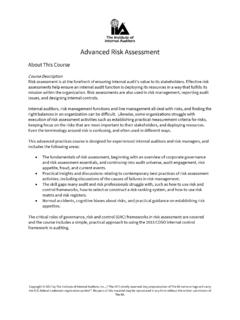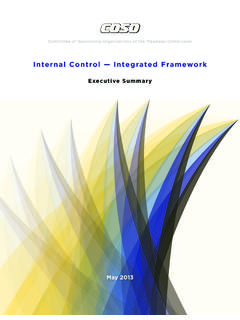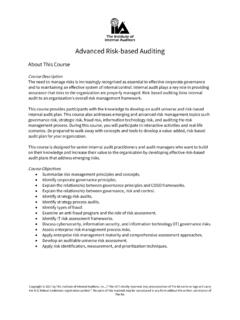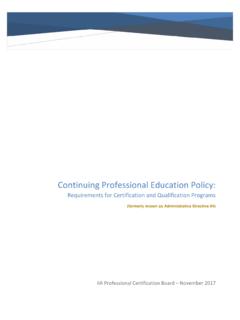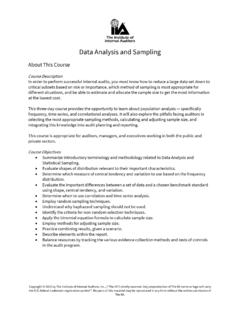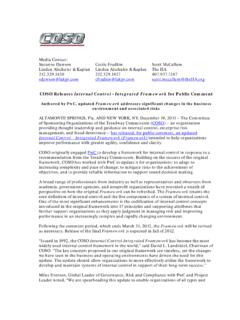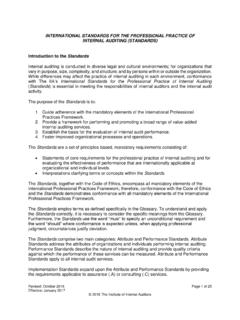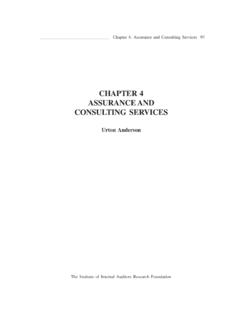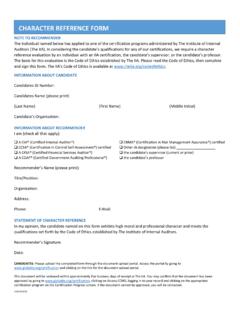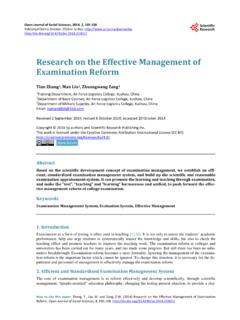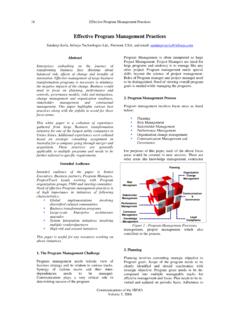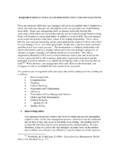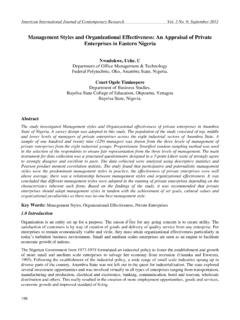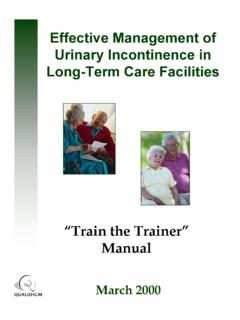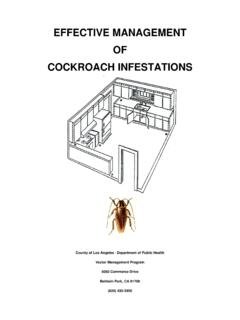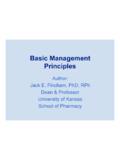Transcription of THE THREE LINES OF DEFENSE IN EFFECTIVE RISK …
1 IIA Position Paper: THE THREE LINES OF DEFENSE IN EFFECTIVE RISK management AND CONTROLJANUARY 2013 TABLE OF CONTENTSI ntroduction ..1 Before the THREE LINES : Risk management Oversight and Strategy-Setting ..2 The First Line of DEFENSE : Operational management ..3 The Second Line of DEFENSE : Risk management and Compliance Functions ..4 The Third Line of DEFENSE : Internal Audit ..5 External Auditors, Regulators, and Other External Bodies ..6 Coordinating The THREE LINES of DEFENSE ..6 IIA POSITION PAPER: THE THREE LINES OF DEFENSE IN EFFECTIVE RISK management AND CONTROL / 1 IIA POSITION PAPER: THE THREE LINES OF DEFENSE IN EFFECTIVE RISK management AND CONTROL INTRODUCTIONIn twenty-first century businesses, it s not uncommon to find diverse teams of internal auditors, enterprise risk management specialists, compliance officers, internal control specialists, quality inspectors, fraud investiga-tors, and other risk and control professionals working together to help their organizations manage risk.
2 Each of these specialties has a unique perspective and specific skills that can be invaluable to the organizations they serve, but because duties related to risk management and control are increasingly being split across multiple departments and divisions, duties must be coordinated carefully to assure that risk and control processes operate as intended. It s not enough that the various risk and control functions exist the chal-lenge is to assign specific roles and to coordinate effectively and efficiently among these groups so that there are neither gaps in controls nor unneces-sary duplications of coverage. Clear responsibilities must be defined so that each group of risk and control professionals understands the boundaries of their responsibilities and how their positions fit into the organization s overall risk and control structure. The stakes are high. Without a cohesive, coordinated approach, limited risk and control resources may not be deployed effectively, and significant risks may not be identified or managed appropriately.
3 In the worst cases, commu-nications among the various risk and control groups may devolve to little more than an ongoing debate about whose job it is to accomplish specific tasks. The problem can exist at any organization, regardless of whether a formal enterprise risk management framework is used. Although risk management frameworks can effectively identify the types of risks that modern businesses must control, these frameworks are largely silent about how specific duties should be assigned and coordinated within the organization. 2 / IIA POSITION PAPER: THE THREE LINES OF DEFENSE IN EFFECTIVE RISK management AND CONTROLF ortunately, best practices are emerging that can help organizations delegate and coordinate essential risk management duties with a systematic approach. The THREE LINES of DEFENSE model provides a simple and EFFECTIVE way to enhance communications on risk management and control by clarifying essential roles and duties. It provides a fresh look at operations, helping to assure the ongoing success of risk management initiatives, and it is appropri-ate for any organization regardless of size or complexity.
4 Even in organiza-tions where a formal risk management framework or system does not exist, the THREE LINES of DEFENSE model can enhance clarity regarding risks and controls and help improve the effectiveness of risk management systems. BEFORE THE THREE LINES : RISK management OVERSIGHT AND STRATEGY-SETTINGIn the THREE LINES of DEFENSE model, management control is the fi rst line of DEFENSE in risk management , the various risk control and compliance over-sight functions established by management are the second line of DEFENSE , and independent assurance is the third. Each of these THREE LINES plays a distinct role within the organization s wider governance framework. Although neither governing bodies nor senior management are considered to be among the THREE LINES in this model, no discussion of risk management systems could be complete without fi rst considering the essential roles of both governing bodies ( , boards of directors or equivalent bodies) and senior management .
5 Governing bodies and senior management are the primary stakeholders served by the LINES , and they are the parties best positioned to help ensure that the THREE LINES of DEFENSE model is refl ected in the organization s risk management and control audit RegulatorGoverning Body / Board / Audit CommitteeGoverning Body / Board / Audit CommitteeThe THREE LINES of DEFENSE ModelSenior ManagementSenior Management3rd Line of Defense3rd Line of DefenseInternalInternalAuditAudit1st Line of Defense1st Line of DefenseManagementManagementControlsContr olsInternalInternalControlControlMeasure sMeasures2nd Line of Defense2nd Line of DefenseFinancial ControlFinancial ControlSecuritySecurityRisk ManagementRisk ManagementQualityQualityInspectionInspec tionComplianceComplianceAdapted from ECIIA/FERMA Guidance on the 8th EU Company Law Directive, article 41 IIA POSITION PAPER: THE THREE LINES OF DEFENSE IN EFFECTIVE RISK management AND CONTROL / 3 Senior management and governing bodies collectively have responsibility and accountability for setting the organization s objectives, defining strate-gies to achieve those objectives, and establishing governance structures and processes to best manage the risks in accomplishing those objectives.
6 The THREE LINES of DEFENSE model is best implemented with the active support and guidance of the organization s governing body and senior FIRST LINE OF DEFENSE : OPERATIONAL management The THREE LINES of DEFENSE model distinguishes among THREE groups (or LINES ) involved in EFFECTIVE risk management : Functions that own and manage risks. Functions that oversee risks. Functions that provide independent the first line of DEFENSE , operational managers own and manage risks. They also are responsible for implementing corrective actions to address process and control deficiencies. Operational management is responsible for maintaining EFFECTIVE internal controls and for executing risk and control procedures on a day-to-day basis. Operational management identifies, assesses, controls, and mitigates risks, guiding the development and implementation of internal policies and proce-dures and ensuring that activities are consistent with goals and objectives. Through a cascading responsibility structure, mid-level managers design and implement detailed procedures that serve as controls and supervise execution of those procedures by their employees.
7 Operational management naturally serves as the first line of DEFENSE because controls are designed into systems and processes under their guidance of op-erational management . There should be adequate managerial and supervisory controls in place to ensure compliance and to highlight control breakdown, inadequate processes, and unexpected events. 4 / IIA POSITION PAPER: THE THREE LINES OF DEFENSE IN EFFECTIVE RISK management AND CONTROLTHE SECOND LINE OF DEFENSE : RISK management AND COMPLIANCE FUNCTIONSIn a perfect world, perhaps only one line of DEFENSE would be needed to as-sure EFFECTIVE risk management . In the real world, however, a single line of DEFENSE often can prove inadequate. management establishes various risk management and compliance functions to help build and/or monitor the first line-of- DEFENSE controls. The specific functions will vary by organization and industry, but typical functions in this second line of DEFENSE include: A risk management function (and/or committee) that facilitates and monitors the implementation of EFFECTIVE risk management practices by operational management and assists risk owners in defining the target risk exposure and reporting adequate risk-related information throughout the organization.
8 A compliance function to monitor various specific risks such as noncompliance with applicable laws and regulations. In this capacity, the separate function reports directly to senior management , and in some business sectors, directly to the governing body. Multiple compliance functions often exist in a single organization, with responsibility for specific types of compliance monitoring, such as health and safety, supply chain, environmental, or quality monitoring. A controllership function that monitors financial risks and financial reporting establishes these functions to ensure the first line of DEFENSE is properly designed, in place, and operating as intended. Each of these func-tions has some degree of independence from the first line of DEFENSE , but they are by nature management functions. As management functions, they may intervene directly in modifying and developing the internal control and risk systems. Therefore, the second line of DEFENSE serves a vital purpose but cannot offer truly independent analyses to governing bodies regarding risk management and internal responsibilities of these functions vary on their specific nature, but can include: Supporting management policies, defining roles and responsibilities, and setting goals for implementation.
9 Providing risk management frameworks. Identifying known and emerging issues. Identifying shifts in the organization s implicit risk appetite. Assisting management in developing processes and controls to manage risks and POSITION PAPER: THE THREE LINES OF DEFENSE IN EFFECTIVE RISK management AND CONTROL / 5 Providing guidance and training on risk management processes. Facilitating and monitoring implementation of EFFECTIVE risk management practices by operational management . Alerting operational management to emerging issues and changing regulatory and risk scenarios. Monitoring the adequacy and effectiveness of internal control, accuracy and completeness of reporting, compliance with laws and regulations, and timely remediation of deficiencies. THE THIRD LINE OF DEFENSE : INTERNAL AUDIT Internal auditors provide the governing body and senior management with comprehensive assurance based on the highest level of independence and objectivity within the organization.
10 This high level of independence is not available in the second line of DEFENSE . Internal audit provides assurance on the effectiveness of governance, risk management , and internal controls, including the manner in which the first and second LINES of DEFENSE achieve risk management and control objectives. The scope of this assurance, which is reported to senior management and to the governing body, usually covers: A broad range of objectives, including efficiency and effectiveness of operations; safeguarding of assets; reliability and integrity of reporting processes; and compliance with laws, regulations, policies, procedures, and contracts. All elements of the risk management and internal control framework, which includes: internal control environment; all elements of an organization s risk management framework ( , risk identification, risk assessment, and response); information and communication; and monitoring. The overall entity, divisions, subsidiaries, operating units, and functions including business processes, such as sales, production, marketing, safety, customer functions, and opera-tions as well as supporting functions ( , revenue and expenditure accounting, human resources, purchasing, payroll, budgeting, infrastructure and asset management , inventory, and information technology).
